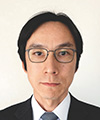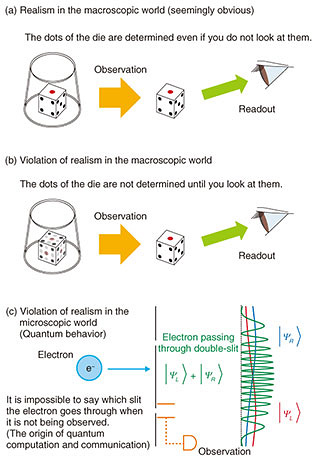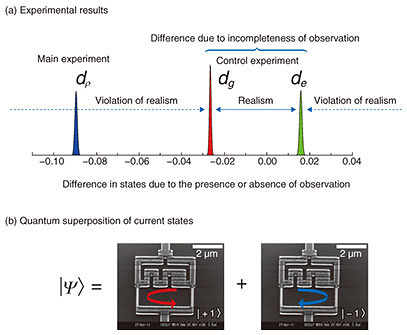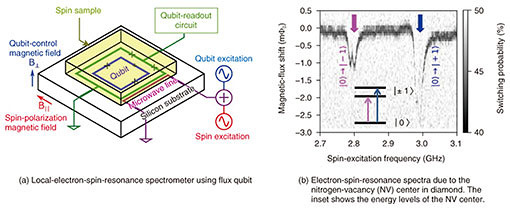 |
|||||||||||||
|
|
|||||||||||||
|
Front-line Researchers Vol. 19, No. 11, pp. 6–12, Nov. 2021. https://doi.org/10.53829/ntr202111fr1  Where There Is Will, There Is a Way. Researchers, Be Long-term OptimistsOverviewQuantum information technology is attracting attention as a source of technological innovation that will bring about major changes in the future economy and society. Countries around the world, including Japan, the United States, Europe, and China, are positioning research and development of quantum information technology as one of their national strategies. We interviewed Shiro Saito, a senior distinguished researcher at NTT Basic Research Laboratories and who is making a significant contribution to the development of quantum information technology, about the progress of his research and his attitude as a researcher. Keywords: quantum information technology, superconducting flux qubit, macroscopic quantum phenomena Research on new devices that contributes to the development of quantum information technology—Please tell us about your current research. Quantum mechanics is applied in various devices—ranging from semiconductor devices to lasers and magnetic resonance imaging systems—and I am researching quantum information technology using superconducting quantum circuits. Quantum information technology provides high-performance functions unattainable with conventional technology by skillfully controlling quantum states, which are vulnerable to external noise and have a short lifetime. Superconducting quantum circuits, which are composed of superconducting elements with quantum properties, have been extensively researched with the aim of developing quantum computers. As a result of the improvement in quantum-state-control techniques, applications of superconducting quantum circuits to quantum devices other than quantum computers, such as quantum sensors, have begun to be explored. The origin of research on superconducting quantum circuits is the question, “Does the violation of realism that occurs in the world of quantum mechanics occur in the macroscopic world we live in?” Clarifying the question will lead us to the creation of quantum computers that enable massively parallel computing without consuming high energy and quantum sensors that enable highly sensitive sensing that exceeds the limits of the past. Realism or violation of realism means, for example, if you roll a die under a paper cup, the die’s dots are determined even if you do not observe them from the outside, as shown in Fig. 1, and this phenomenon is called realism. However, in the world of quantum mechanics, violation of realism occurs, that is, the dots on the die under the cup are in a superposition state and determined only when they are observed with the eye by lifting the cup.
In an experiment we conducted, a single electron was sent through a double-slit one by one. When we took a number of measurements of the position of the single electron by using a detector placed at a certain position behind the slit, the position of the electron came together to form a wave pattern (i.e., interference fringes). This phenomenon can be explained as follows. Each time the single electron passes through a double-slit, a state called “superposition” occurs, namely, the electron is superposed between one through the upper slit and the other through the lower slit every time it is sent, and the place where the electrons gather is determined by the interference effect. The interference fringe is a proof of the superposition state, namely violation of realism. However, when we try to measure which slit the electron passed through, the interference fringe disappears. The travel direction of the electron is determined at the moment its passage through the slit is measured, and the electron does not travel in the direction to form the interference fringe. This is the consequence of realism. Violation of realism has been confirmed in the nanometer-sized microscopic world of electrons, atoms, etc., and the origin of research on superconducting quantum circuits has been whether such phenomenon occurs in the macroscopic world. —I heard that you have achieved pioneering results. Please tell us about your recent achievements. In 2016, in collaboration with the University of Illinois, USA, we successfully demonstrated violation of realism concerning superconducting currents using a superconducting flux qubit (Fig. 2). As I mentioned with the earlier question, if the macroscopic world follows quantum mechanics, violation of realism should also occur. The question of whether this violation occurs in the macroscopic world or whether it is not owing to the limitations of quantum mechanics (i.e., the macroscopic realism problem) has been an unsolved problem since the dawn of quantum mechanics. A current of 170 nA (equivalent to 1012 electrons flowing per second) flows through a superconducting flux qubit. Our recent results indicate that realism is violated in this current, and our demonstration that quantum mechanics is applicable on the macroscopic scale, i.e., current states, will significantly contribute to the field of fundamental physics. It also confirms that superconducting flux qubits can work as quantum devices that use true quantum properties. The results were published in the online edition of the British scientific journal Nature Communications [1].
In 2019, we demonstrated electron-spin resonance using a superconducting flux qubit, which makes it possible to analyze a small-volume sample containing several dozens of electron spins (Fig. 3).
This research on quantum sensing using superconducting qubits is part of the “Creation of Innovative Quantum Technology Platform Based on Advanced Control of Quantum States” project supported by the Japan Science and Technology Agency’s Core Research for Evolutional Science and Technology (CREST) program [2]. Electron-spin resonance spectroscopy is one analytical method for investigating the properties of electron spins in materials and is widely used for analysis of molecular structures. However, analysis with a current electron-spin-resonance spectrometer requires a sample containing a large number of electron spins, namely, about 1013, and a sample volume of several milliliters. As a result, the samples that can be analyzed are limited. A superconducting flux qubit functions as a highly sensitive magnetometer. We have demonstrated electron-spin resonance spectroscopy by using this magnetometer to detect electron spins, which have the properties of a tiny magnet. We succeeded in detecting about 400 electron spins in a 0.05-pL sample volume. The development of a new electron-spin-resonance spectroscopy method that can be used to analyze a material sample containing a small number of spins in a minute volume is considered to contribute to a wide range of fields from basic science to material characterization, bioanalysis, and medical applications. This achievement was published in 2019 in the online version of the British scientific journal Communications Physics [3]. Then, in 2020, the detection volume reached 0.006 pL, and the detection sensitivity reached 20 electron spins [4]. We are currently working on the “Development of Integration Technologies for Superconducting Quantum Circuits” project as part of the national Moonshot Research & Development Program launched in December 2020 entitled “Realization of a fault-tolerant universal quantum computer that will revolutionize economy, industry, and security by 2050” [5, 6]. Curiosity toward macroscopic quantum phenomena—How do you feel about the expansion and fulfillment of your research field? Looking at the field of superconducting quantum circuits as a whole from the perspective of a pioneer, I feel that this field is evolving ever more rapidly. In the beginning, the activities were small scale and slow, but as the potential of this field was revealed, researchers from academia and industry, as well as outstanding researchers in a wide variety of fields other than superconductivity, joined the field. This situation has created an interesting trend; for example, when high-temperature superconductivity was in vogue, researchers in the field of quantum circuits studied high-temperature superconductivity as a primary theme then returned to quantum circuits to advance them dramatically. Starting from pursuing the question of violation of realism by creating macroscopic superposition, in 2016, we were able to answer that question not only phenomenologically but also mathematically. During that time, quantum technology had matured, and the quantum field had become a focus of public attention. Twenty years ago, only a handful of researchers were working on superconducting quantum circuits; however, a huge number of groups are now working on them, and new papers are being published every day. On reading those papers, I feel a difference between the volume of resources we have and those of the USA, Europe, and China. In the field of quantum computing, the USA—led by Google, IBM, and others—is investing heavily and seems to have the upper hand. Under these circumstances, I believe that Japanese research institutes must join forces in the field of quantum research. If each research lab were to work on its own, it would be left behind by the rest of the world; therefore, it is necessary for each lab to take charge of a research theme it has expertise in and combine them to compete with the rest of the world. Having played a pioneering role in this field, I try to conduct research that is one step ahead and will be useful in the future. My participation in the Moonshot project on quantum error correction is one example of such research. Although our resources in terms of both funding and human resources may be an order of magnitude less than those overseas, I believe that my role is to draw a picture that attracts outstanding researchers by effectively promoting new initiatives and using the achievements as material. In drawing such a picture, I feel that it was very meaningful to participate in the new projects of CREST and Moonshot that I mentioned earlier. Quantum technology is a hot topic attracting much attention, and I think it is important to demonstrate the unique characteristics of NTT. I think that this field is now in the phase of thinking about what can be done with new ideas. When considering the overall development of the field, I believe that we shouldn’t put too much pressure on researchers; instead, we should give them a certain degree of freedom. If we put excessive pressure on them, their ideas will be meager, and that situation will affect the development of the field as a whole. —What has supported you in your pursuit of quantum technology for the past 20 years since you joined NTT? My starting point was curiosity about macroscopic quantum phenomena. When I was at university, I studied superconductivity; however, neither the environment nor the technology needed to investigate macroscopic quantum phenomena was available, so I joined NTT because I admired its environment and system. Researchers should be motivated to work on something because they are interested in or because there is an unknown in a particular field. For example, the main reason that I’m devoted to quantum technology is that when I was a university student, I admired the research of Prof. Yasunobu Nakamura (who is currently at the University of Tokyo), who was the first person in the world to demonstrate quantum superposition in a superconducting circuit. I was hooked by the wonder of creating superpositions in the macroscopic realm. Prof. Nakamura is now in a position to coordinate research on quantum computers in Japan, and I’m now able to tackle such research from a different angle. One time, Prof. Nakamura said to me, “I remember a student who asked me questions in particular detail during a special lecture, and it turned out it was you, Prof. Saito.” That explains how much I admired Prof. Nakamura’s research. With that memory in mind, I try to convey to students who come to NTT for training that research is an interesting world. Perhaps the way of thinking behind the saying “Where there is a will, there is a way” can support our research life. I think researchers need to be “long-term optimists.” Although I have always believed in that saying and have always believed that any problems can be solved, I was unable to achieve success for a while after joining the company. It was around the time when the qubit I created had a short lifetime and could not be superposed. Still believing that “Where there is a will, there is a way” and that if I make improvements steadily, the lifetime of the qubit will be extended, I continued to improve the samples and measurement system. Then, in the middle of the night at the laboratory, I saw Rabi oscillations in the qubit signal indicating superposition. I was really excited when I was able to confirm the data for the first time; I even jumped for joy in our large, empty gymnasium-like laboratory alone. I think experiencing that kind of success makes us expect to achieve further success. Cherish your connections with people—What do you keep in mind when determining a research theme? When determining a new theme, I first analyze the current situation then select a theme that will allow me to find a new method or novelty. For example, it is important to (i) understand your strengths and the trends being followed by other researchers in your research area by comparing their strengths with yours and (ii) narrow down the theme you should pursue while considering the direction in which you can come up with something new. Although it depends on the research phase and field, the current field of superconducting circuits, for example, is quite broad, so it is necessary to survey how far each area within it has progressed. The number of papers published in the field is considerable, so it may be difficult to keep track of the overall research. Even so, if you do not keep track properly, you may go in a wasteful direction or even if you produce results, they might not receive proper appraisal. I also tried my hand at creating macroscopic superposition by trial and error. However, time is not infinite, so I try to get a general idea of the direction of the field of superconducting quantum circuits by reading papers, including references, published by groups who are making progress in the field. The references are particularly very useful for obtaining an overview of the field since they contain most of the relevant papers in the field. You should select the theme you are interested in. Regarding macroscopic superposition, it is necessary to extend the lifetime of the qubit. Therefore, I was excited to see that the lifetime of the qubit had recently begun to extend again, and that excitement confirmed that I do really like studying macroscopic superposition. In addition to being aware of this emotion, it is also important to be interested in what is right and new. For example, I’m exploring a new direction called “bosonic codes” and am applying my accumulated knowledge of qubits to build a new quantum system based on bosonic codes. I want to make the most of the foundations that we have built but also want to look for new things.
—What would you like to say to our young researchers? Young researchers, cherish your connections with people. I say that because connecting with people gives us new knowledge, and collaboration with researchers in completely different fields can bring new perspectives. For example, when we were trying to develop a bosonic code in the Moonshot project, I was looking to collaborate with researchers fabricating a high-Q (quality factor) cavity for storing bosonic qubit information and was able to connect with certain collaborators as a result of casual conversation that took place in a symposium. As another example, I was considering using diamond as a material that might improve the limit on coherence time (i.e., the timescale over which the quantum information stored in the qubit is lost) of the superconducting qubit. Coincidentally, around that time, a superior of mine casually started a conversation with a researcher sitting next to him at lunch during a conference, and it turned out that the researcher was an expert on diamond. Following the advice given by that expert led us to achieve outstanding results. These experiences made me recognize the importance of showing up at places where researchers gather and connecting with them. Therefore, I hope that you will value your interactions with others—both inside and outside NTT. During your research activities, you don’t have to be bound by the purpose of your research. A research goal can have derivation and detours. There are many different ways to achieve goals, and I think it is good to have a variety of offshoots. If you put 90% of your energy into your research theme and the remaining 10% into something completely unrelated, you will be able to broaden the scope your research. Convey to people what you want to do. Opportunities even lie in casual conversations in daily life. I encourage you to pursue a research theme that you are interested in while maintaining your curiosity. References
■Interviewee profileShiro SaitoSenior Distinguished Researcher and Group Leader of Superconducting Quantum Circuits Research Group, NTT Basic Research Laboratories. He received a B.E., M.E., and Dr.Eng. in applied physics from the University of Tokyo in 1995, 1997, and 2000. He joined NTT Basic Research Laboratories in 2000. Since then he has been engaged in quantum information processing using superconducting circuits. He was a guest researcher at Delft University of Technology from 2005 to 2006 and a guest associate professor at Tokyo University of Science from 2012 to 2020, where he is currently a guest professor. He was appointed as a distinguished researcher of NTT in 2012 and senior distinguished researcher in 2021. He is a member of the Physical Society of Japan and the Japan Society of Applied Physics. |
|||||||||||||




